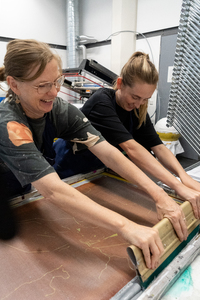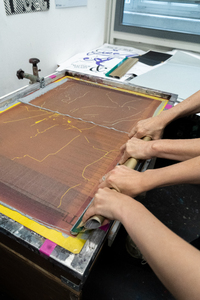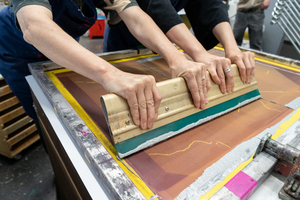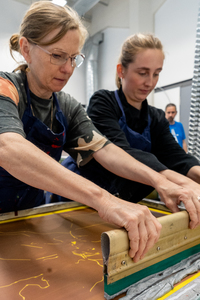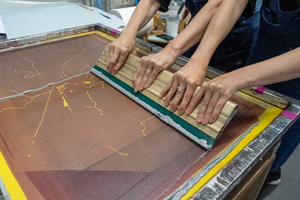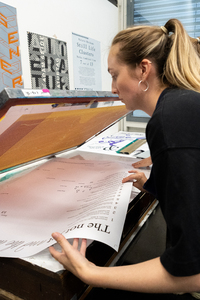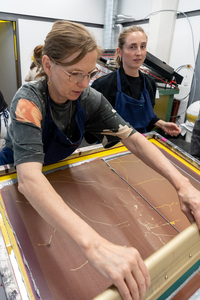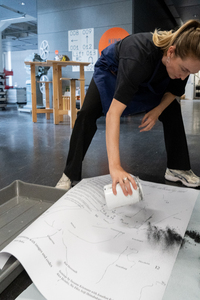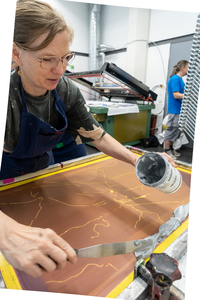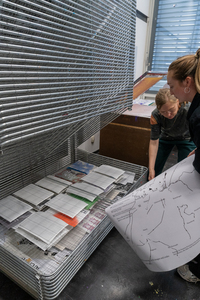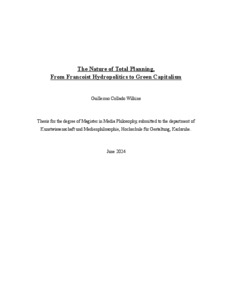"Sommersemester 2024"
| Begriff | Sommersemester 2024 |
| Metakey | Semester (institution:semester) |
| Typ | Keyword |
| Vokabular | HfG |
306 Inhalte
- Seite 1 von 26
Dusting. Ecosystems with images and codes
- Titel
- Dusting. Ecosystems with images and codes
- Schlagworte
- Datierung
- 30.04.2024 - 16.07.2024
- Titel
- Dusting. Ecosystems with images and codes
- Titel (en)
- Dusting. Ecosystems with images and codes
- Urheberrechtshinweis
- © Staatliche Hochschule für Gestaltung Karlsruhe, Foto: Matylda Eaton
- Rechtsschutz/Lizenz
- Freigabe Nutzung HfG
- Medienersteller/in
- Medien-Beschreibung
- Dokumentation des Seminars:
Dusting. Ecosystems with images and codes
“No matter how desperately you fight against it, dust pervades everything. It accumulates in fuzzy balls or gathers in even layers, adapting to the contours of things and making the passage of time. In itself, it is also a gathering place, a random community of what has been and what is yet to be, a catalog of traces, an inventory of threats, and a set of promises… “ Michael Marder, “Dust” 2016 In this seminar we will look at different situations with images and codes where dust engages as a medium to understand the complex interrelation between the content of an image and its making, its meta-data and its technological and ecological being in the world. The seminare is practical as well as theoretical. We will dust together, and we will wait for dust to settle: on paper, in space, in our minds, and we will research and engage in dust experiments together: from field trips to laboratory visit to exhibition visits. At the end of the seminar the aim is to have delevoped a presentation, be it an image series, an installation, or/ and a research exhibition. This will be presented during the Rundgang. Prof. Susanne Kriemann organises an excursion to Vienna 24th to 27th of April to see the exhibition “Into the Woods” at KunstHausWien and the first “Klima-Biennale”.
- Dokumentation des Seminars:
- Abgebildete Personen
- Projektleiter/in
- Semester
- Studiengang
- Importiert am
- 22.08.2024
- Übergeordnete Sets
- 2
Dusting. Ecosystems with images and codes
- Titel
- Dusting. Ecosystems with images and codes
- Schlagworte
- Datierung
- 30.04.2024 - 16.07.2024
- Titel
- Dusting. Ecosystems with images and codes
- Titel (en)
- Dusting. Ecosystems with images and codes
- Urheberrechtshinweis
- © Staatliche Hochschule für Gestaltung Karlsruhe, Foto: Matylda Eaton
- Rechtsschutz/Lizenz
- Freigabe Nutzung HfG
- Medienersteller/in
- Medien-Beschreibung
- Dokumentation des Seminars:
Dusting. Ecosystems with images and codes
“No matter how desperately you fight against it, dust pervades everything. It accumulates in fuzzy balls or gathers in even layers, adapting to the contours of things and making the passage of time. In itself, it is also a gathering place, a random community of what has been and what is yet to be, a catalog of traces, an inventory of threats, and a set of promises… “ Michael Marder, “Dust” 2016 In this seminar we will look at different situations with images and codes where dust engages as a medium to understand the complex interrelation between the content of an image and its making, its meta-data and its technological and ecological being in the world. The seminare is practical as well as theoretical. We will dust together, and we will wait for dust to settle: on paper, in space, in our minds, and we will research and engage in dust experiments together: from field trips to laboratory visit to exhibition visits. At the end of the seminar the aim is to have delevoped a presentation, be it an image series, an installation, or/ and a research exhibition. This will be presented during the Rundgang. Prof. Susanne Kriemann organises an excursion to Vienna 24th to 27th of April to see the exhibition “Into the Woods” at KunstHausWien and the first “Klima-Biennale”.
- Dokumentation des Seminars:
- Abgebildete Personen
- Projektleiter/in
- Semester
- Studiengang
- Importiert am
- 22.08.2024
- Übergeordnete Sets
- 2
Dusting. Ecosystems with images and codes
- Titel
- Dusting. Ecosystems with images and codes
- Schlagworte
- Datierung
- 30.04.2024 - 16.07.2024
- Titel
- Dusting. Ecosystems with images and codes
- Titel (en)
- Dusting. Ecosystems with images and codes
- Urheberrechtshinweis
- © Staatliche Hochschule für Gestaltung Karlsruhe, Foto: Matylda Eaton
- Rechtsschutz/Lizenz
- Freigabe Nutzung HfG
- Medienersteller/in
- Medien-Beschreibung
- Dokumentation des Seminars:
Dusting. Ecosystems with images and codes
“No matter how desperately you fight against it, dust pervades everything. It accumulates in fuzzy balls or gathers in even layers, adapting to the contours of things and making the passage of time. In itself, it is also a gathering place, a random community of what has been and what is yet to be, a catalog of traces, an inventory of threats, and a set of promises… “ Michael Marder, “Dust” 2016 In this seminar we will look at different situations with images and codes where dust engages as a medium to understand the complex interrelation between the content of an image and its making, its meta-data and its technological and ecological being in the world. The seminare is practical as well as theoretical. We will dust together, and we will wait for dust to settle: on paper, in space, in our minds, and we will research and engage in dust experiments together: from field trips to laboratory visit to exhibition visits. At the end of the seminar the aim is to have delevoped a presentation, be it an image series, an installation, or/ and a research exhibition. This will be presented during the Rundgang. Prof. Susanne Kriemann organises an excursion to Vienna 24th to 27th of April to see the exhibition “Into the Woods” at KunstHausWien and the first “Klima-Biennale”.
- Dokumentation des Seminars:
- Abgebildete Personen
- Projektleiter/in
- Semester
- Studiengang
- Importiert am
- 22.08.2024
- Übergeordnete Sets
- 2
Dusting. Ecosystems with images and codes
- Titel
- Dusting. Ecosystems with images and codes
- Schlagworte
- Datierung
- 30.04.2024 - 16.07.2024
- Titel
- Dusting. Ecosystems with images and codes
- Titel (en)
- Dusting. Ecosystems with images and codes
- Urheberrechtshinweis
- © Staatliche Hochschule für Gestaltung Karlsruhe, Foto: Matylda Eaton
- Rechtsschutz/Lizenz
- Freigabe Nutzung HfG
- Medienersteller/in
- Medien-Beschreibung
- Dokumentation des Seminars:
Dusting. Ecosystems with images and codes
“No matter how desperately you fight against it, dust pervades everything. It accumulates in fuzzy balls or gathers in even layers, adapting to the contours of things and making the passage of time. In itself, it is also a gathering place, a random community of what has been and what is yet to be, a catalog of traces, an inventory of threats, and a set of promises… “ Michael Marder, “Dust” 2016 In this seminar we will look at different situations with images and codes where dust engages as a medium to understand the complex interrelation between the content of an image and its making, its meta-data and its technological and ecological being in the world. The seminare is practical as well as theoretical. We will dust together, and we will wait for dust to settle: on paper, in space, in our minds, and we will research and engage in dust experiments together: from field trips to laboratory visit to exhibition visits. At the end of the seminar the aim is to have delevoped a presentation, be it an image series, an installation, or/ and a research exhibition. This will be presented during the Rundgang. Prof. Susanne Kriemann organises an excursion to Vienna 24th to 27th of April to see the exhibition “Into the Woods” at KunstHausWien and the first “Klima-Biennale”.
- Dokumentation des Seminars:
- Abgebildete Personen
- Projektleiter/in
- Semester
- Studiengang
- Importiert am
- 22.08.2024
- Übergeordnete Sets
- 2
Dusting. Ecosystems with images and codes
- Titel
- Dusting. Ecosystems with images and codes
- Schlagworte
- Datierung
- 30.04.2024 - 16.07.2024
- Titel
- Dusting. Ecosystems with images and codes
- Titel (en)
- Dusting. Ecosystems with images and codes
- Urheberrechtshinweis
- © Staatliche Hochschule für Gestaltung Karlsruhe, Foto: Matylda Eaton
- Rechtsschutz/Lizenz
- Freigabe Nutzung HfG
- Medienersteller/in
- Medien-Beschreibung
- Dokumentation des Seminars:
Dusting. Ecosystems with images and codes
“No matter how desperately you fight against it, dust pervades everything. It accumulates in fuzzy balls or gathers in even layers, adapting to the contours of things and making the passage of time. In itself, it is also a gathering place, a random community of what has been and what is yet to be, a catalog of traces, an inventory of threats, and a set of promises… “ Michael Marder, “Dust” 2016 In this seminar we will look at different situations with images and codes where dust engages as a medium to understand the complex interrelation between the content of an image and its making, its meta-data and its technological and ecological being in the world. The seminare is practical as well as theoretical. We will dust together, and we will wait for dust to settle: on paper, in space, in our minds, and we will research and engage in dust experiments together: from field trips to laboratory visit to exhibition visits. At the end of the seminar the aim is to have delevoped a presentation, be it an image series, an installation, or/ and a research exhibition. This will be presented during the Rundgang. Prof. Susanne Kriemann organises an excursion to Vienna 24th to 27th of April to see the exhibition “Into the Woods” at KunstHausWien and the first “Klima-Biennale”.
- Dokumentation des Seminars:
- Abgebildete Personen
- Projektleiter/in
- Semester
- Studiengang
- Importiert am
- 22.08.2024
- Übergeordnete Sets
- 2
Dusting. Ecosystems with images and codes
- Titel
- Dusting. Ecosystems with images and codes
- Schlagworte
- Datierung
- 30.04.2024 - 16.07.2024
- Titel
- Dusting. Ecosystems with images and codes
- Titel (en)
- Dusting. Ecosystems with images and codes
- Urheberrechtshinweis
- © Staatliche Hochschule für Gestaltung Karlsruhe, Foto: Matylda Eaton
- Rechtsschutz/Lizenz
- Freigabe Nutzung HfG
- Medienersteller/in
- Medien-Beschreibung
- Dokumentation des Seminars:
Dusting. Ecosystems with images and codes
“No matter how desperately you fight against it, dust pervades everything. It accumulates in fuzzy balls or gathers in even layers, adapting to the contours of things and making the passage of time. In itself, it is also a gathering place, a random community of what has been and what is yet to be, a catalog of traces, an inventory of threats, and a set of promises… “ Michael Marder, “Dust” 2016 In this seminar we will look at different situations with images and codes where dust engages as a medium to understand the complex interrelation between the content of an image and its making, its meta-data and its technological and ecological being in the world. The seminare is practical as well as theoretical. We will dust together, and we will wait for dust to settle: on paper, in space, in our minds, and we will research and engage in dust experiments together: from field trips to laboratory visit to exhibition visits. At the end of the seminar the aim is to have delevoped a presentation, be it an image series, an installation, or/ and a research exhibition. This will be presented during the Rundgang. Prof. Susanne Kriemann organises an excursion to Vienna 24th to 27th of April to see the exhibition “Into the Woods” at KunstHausWien and the first “Klima-Biennale”.
- Dokumentation des Seminars:
- Abgebildete Personen
- Projektleiter/in
- Semester
- Studiengang
- Importiert am
- 22.08.2024
- Übergeordnete Sets
- 2
Dusting. Ecosystems with images and codes
- Titel
- Dusting. Ecosystems with images and codes
- Schlagworte
- Datierung
- 30.04.2024 - 16.07.2024
- Titel
- Dusting. Ecosystems with images and codes
- Titel (en)
- Dusting. Ecosystems with images and codes
- Urheberrechtshinweis
- © Staatliche Hochschule für Gestaltung Karlsruhe, Foto: Matylda Eaton
- Rechtsschutz/Lizenz
- Freigabe Nutzung HfG
- Medienersteller/in
- Medien-Beschreibung
- Dokumentation des Seminars:
Dusting. Ecosystems with images and codes
“No matter how desperately you fight against it, dust pervades everything. It accumulates in fuzzy balls or gathers in even layers, adapting to the contours of things and making the passage of time. In itself, it is also a gathering place, a random community of what has been and what is yet to be, a catalog of traces, an inventory of threats, and a set of promises… “ Michael Marder, “Dust” 2016 In this seminar we will look at different situations with images and codes where dust engages as a medium to understand the complex interrelation between the content of an image and its making, its meta-data and its technological and ecological being in the world. The seminare is practical as well as theoretical. We will dust together, and we will wait for dust to settle: on paper, in space, in our minds, and we will research and engage in dust experiments together: from field trips to laboratory visit to exhibition visits. At the end of the seminar the aim is to have delevoped a presentation, be it an image series, an installation, or/ and a research exhibition. This will be presented during the Rundgang. Prof. Susanne Kriemann organises an excursion to Vienna 24th to 27th of April to see the exhibition “Into the Woods” at KunstHausWien and the first “Klima-Biennale”.
- Dokumentation des Seminars:
- Abgebildete Personen
- Projektleiter/in
- Semester
- Studiengang
- Importiert am
- 22.08.2024
- Übergeordnete Sets
- 2
Dusting. Ecosystems with images and codes
- Titel
- Dusting. Ecosystems with images and codes
- Schlagworte
- Datierung
- 30.04.2024 - 16.07.2024
- Titel
- Dusting. Ecosystems with images and codes
- Titel (en)
- Dusting. Ecosystems with images and codes
- Urheberrechtshinweis
- © Staatliche Hochschule für Gestaltung Karlsruhe, Foto: Matylda Eaton
- Rechtsschutz/Lizenz
- Freigabe Nutzung HfG
- Medienersteller/in
- Medien-Beschreibung
- Dokumentation des Seminars:
Dusting. Ecosystems with images and codes
“No matter how desperately you fight against it, dust pervades everything. It accumulates in fuzzy balls or gathers in even layers, adapting to the contours of things and making the passage of time. In itself, it is also a gathering place, a random community of what has been and what is yet to be, a catalog of traces, an inventory of threats, and a set of promises… “ Michael Marder, “Dust” 2016 In this seminar we will look at different situations with images and codes where dust engages as a medium to understand the complex interrelation between the content of an image and its making, its meta-data and its technological and ecological being in the world. The seminare is practical as well as theoretical. We will dust together, and we will wait for dust to settle: on paper, in space, in our minds, and we will research and engage in dust experiments together: from field trips to laboratory visit to exhibition visits. At the end of the seminar the aim is to have delevoped a presentation, be it an image series, an installation, or/ and a research exhibition. This will be presented during the Rundgang. Prof. Susanne Kriemann organises an excursion to Vienna 24th to 27th of April to see the exhibition “Into the Woods” at KunstHausWien and the first “Klima-Biennale”.
- Dokumentation des Seminars:
- Abgebildete Personen
- Projektleiter/in
- Semester
- Studiengang
- Importiert am
- 22.08.2024
- Übergeordnete Sets
- 2
Dusting. Ecosystems with images and codes
- Titel
- Dusting. Ecosystems with images and codes
- Schlagworte
- Datierung
- 30.04.2024 - 16.07.2024
- Titel
- Dusting. Ecosystems with images and codes
- Titel (en)
- Dusting. Ecosystems with images and codes
- Urheberrechtshinweis
- © Staatliche Hochschule für Gestaltung Karlsruhe, Foto: Matylda Eaton
- Rechtsschutz/Lizenz
- Freigabe Nutzung HfG
- Medienersteller/in
- Medien-Beschreibung
- Dokumentation des Seminars:
Dusting. Ecosystems with images and codes
“No matter how desperately you fight against it, dust pervades everything. It accumulates in fuzzy balls or gathers in even layers, adapting to the contours of things and making the passage of time. In itself, it is also a gathering place, a random community of what has been and what is yet to be, a catalog of traces, an inventory of threats, and a set of promises… “ Michael Marder, “Dust” 2016 In this seminar we will look at different situations with images and codes where dust engages as a medium to understand the complex interrelation between the content of an image and its making, its meta-data and its technological and ecological being in the world. The seminare is practical as well as theoretical. We will dust together, and we will wait for dust to settle: on paper, in space, in our minds, and we will research and engage in dust experiments together: from field trips to laboratory visit to exhibition visits. At the end of the seminar the aim is to have delevoped a presentation, be it an image series, an installation, or/ and a research exhibition. This will be presented during the Rundgang. Prof. Susanne Kriemann organises an excursion to Vienna 24th to 27th of April to see the exhibition “Into the Woods” at KunstHausWien and the first “Klima-Biennale”.
- Dokumentation des Seminars:
- Abgebildete Personen
- Projektleiter/in
- Semester
- Studiengang
- Importiert am
- 22.08.2024
- Übergeordnete Sets
- 2
Dusting. Ecosystems with images and codes
- Titel
- Dusting. Ecosystems with images and codes
- Schlagworte
- Datierung
- 30.04.2024 - 16.07.2024
- Titel
- Dusting. Ecosystems with images and codes
- Titel (en)
- Dusting. Ecosystems with images and codes
- Urheberrechtshinweis
- © Staatliche Hochschule für Gestaltung Karlsruhe, Foto: Matylda Eaton
- Rechtsschutz/Lizenz
- Freigabe Nutzung HfG
- Medienersteller/in
- Medien-Beschreibung
- Dokumentation des Seminars:
Dusting. Ecosystems with images and codes
“No matter how desperately you fight against it, dust pervades everything. It accumulates in fuzzy balls or gathers in even layers, adapting to the contours of things and making the passage of time. In itself, it is also a gathering place, a random community of what has been and what is yet to be, a catalog of traces, an inventory of threats, and a set of promises… “ Michael Marder, “Dust” 2016 In this seminar we will look at different situations with images and codes where dust engages as a medium to understand the complex interrelation between the content of an image and its making, its meta-data and its technological and ecological being in the world. The seminare is practical as well as theoretical. We will dust together, and we will wait for dust to settle: on paper, in space, in our minds, and we will research and engage in dust experiments together: from field trips to laboratory visit to exhibition visits. At the end of the seminar the aim is to have delevoped a presentation, be it an image series, an installation, or/ and a research exhibition. This will be presented during the Rundgang. Prof. Susanne Kriemann organises an excursion to Vienna 24th to 27th of April to see the exhibition “Into the Woods” at KunstHausWien and the first “Klima-Biennale”.
- Dokumentation des Seminars:
- Abgebildete Personen
- Projektleiter/in
- Semester
- Studiengang
- Importiert am
- 22.08.2024
- Übergeordnete Sets
- 2
Dusting. Ecosystems with images and codes
- Titel
- Dusting. Ecosystems with images and codes
- Schlagworte
- Datierung
- 30.04.2024 - 16.07.2024
- Titel
- Dusting. Ecosystems with images and codes
- Titel (en)
- Dusting. Ecosystems with images and codes
- Urheberrechtshinweis
- © Staatliche Hochschule für Gestaltung Karlsruhe, Foto: Matylda Eaton
- Rechtsschutz/Lizenz
- Freigabe Nutzung HfG
- Medienersteller/in
- Medien-Beschreibung
- Dokumentation des Seminars:
Dusting. Ecosystems with images and codes
“No matter how desperately you fight against it, dust pervades everything. It accumulates in fuzzy balls or gathers in even layers, adapting to the contours of things and making the passage of time. In itself, it is also a gathering place, a random community of what has been and what is yet to be, a catalog of traces, an inventory of threats, and a set of promises… “ Michael Marder, “Dust” 2016 In this seminar we will look at different situations with images and codes where dust engages as a medium to understand the complex interrelation between the content of an image and its making, its meta-data and its technological and ecological being in the world. The seminare is practical as well as theoretical. We will dust together, and we will wait for dust to settle: on paper, in space, in our minds, and we will research and engage in dust experiments together: from field trips to laboratory visit to exhibition visits. At the end of the seminar the aim is to have delevoped a presentation, be it an image series, an installation, or/ and a research exhibition. This will be presented during the Rundgang. Prof. Susanne Kriemann organises an excursion to Vienna 24th to 27th of April to see the exhibition “Into the Woods” at KunstHausWien and the first “Klima-Biennale”.
- Dokumentation des Seminars:
- Abgebildete Personen
- Projektleiter/in
- Semester
- Studiengang
- Importiert am
- 22.08.2024
- Übergeordnete Sets
- 2
The Nature of Total Planning, From Francoist Hydropolitics to Green Capitalism
- Titel
- The Nature of Total Planning, From Francoist Hydropolitics to Green Capitalism
- Autor/in
- Beschreibung (de)
- Magisterarbeit in Medienphilosophie
- Beschreibung (en)
- Thesis for the degree of Magister in Media Philosophy
- Kategorie
- Schlagworte
- Datierung
- 06.06.2024
- Sprache
- Ort: Institution
- Land
- Titel
- The Nature of Total Planning, From Francoist Hydropolitics to Green Capitalism
- Titel (en)
- The Nature of Total Planning, From Francoist Hydropolitics to Green Capitalism
- Urheberrechtshinweis
- © Guillermo Collado Wilkins
- Rechtsschutz/Lizenz
- Freigabe Nutzung HfG
- Medienersteller/in
- Medien-Beschreibung (en)
- This paper provides a critical examination of ecological planning based on the continuities that it displays across seemingly disparate political projects and historical periods. In order to do so, it draws on the small rural valley of La Bizkaia in Navarre, Spain. It produces an environmental history of the valley through a detailed study of its hydro-forestry resources, periodising such history according to a materialist reading of its ‘metabolic regimes’. That is to say, through the particular configurations between the natural and social orders that dictate life in La Bizkaia.
Initially, the study introduces the valley’s natural characteristics and its property structure, laying the foundations upon which the rest of this paper sits. Subsequently, it undertakes a detailed investigation of Francoist interventions in the 1940s-60s; a massive monoculture of pine trees was planted by the Francoist Forestry Council, which radically undermined La Bizkaia’s natural systems and depopulated it. This paper thus analyses the planning logic behind this natural intervention which, borrowing a term from one of its draftsmen, is named ‘total planning’.
The thesis then explores contemporary management of the valley by the Government of Navarre, which has maintained ownership until this day, aligning its plans with the international protocols and standards characteristic of green capitalism. By looking at projects undertaken in the valley for nature conservation and climate change adaptation, which receive funding from the European Union, this research reveals the continuities between Francoist policies and green capitalism, and how both operate under the logic of Total Planning. Under this planning logic, they both fail to accommodate the unpredictability of political conflict and natural systems.
Planning thus serves as a lens to explore the political and epistemological dimensions of ecological thought, placing a materialist reading of a small case study into the broader context of contemporary ecological intervention.
- This paper provides a critical examination of ecological planning based on the continuities that it displays across seemingly disparate political projects and historical periods. In order to do so, it draws on the small rural valley of La Bizkaia in Navarre, Spain. It produces an environmental history of the valley through a detailed study of its hydro-forestry resources, periodising such history according to a materialist reading of its ‘metabolic regimes’. That is to say, through the particular configurations between the natural and social orders that dictate life in La Bizkaia.
- Alternativ-Text (de)
- Vollständiger Text der Magisterarbeit
- Alternativ-Text (en)
- Complete text of the Magisterarbeit
- Projektleiter/in
- Semester
- Studiengang
- Typ der Abschlussarbeit
- Importiert am
- 22.10.2024
- Übergeordnete Sets
- 1
